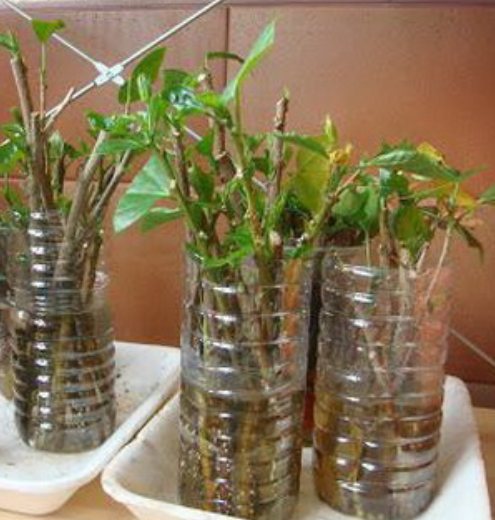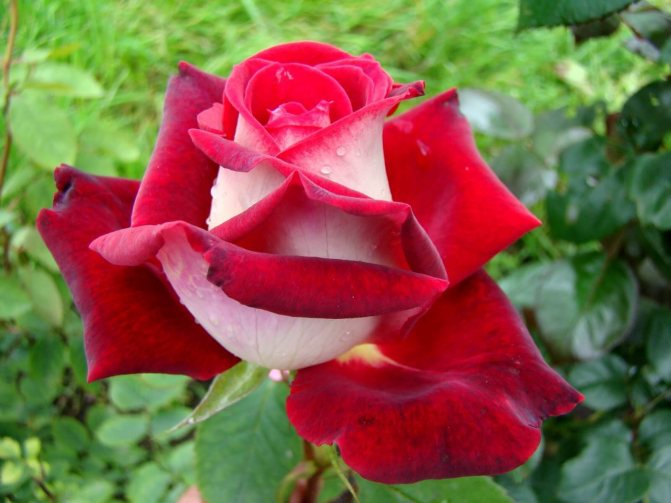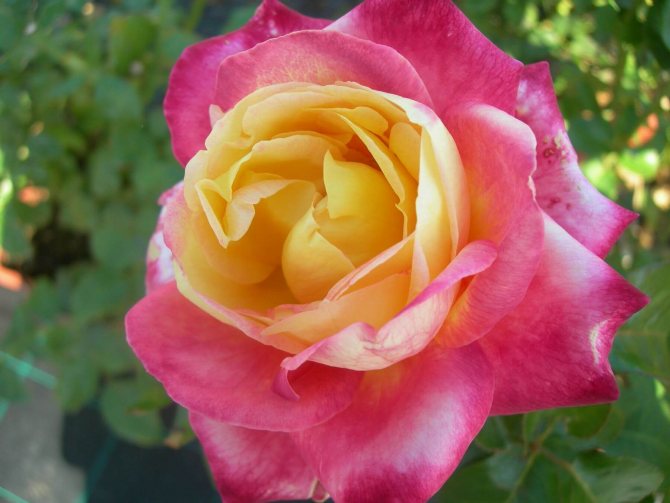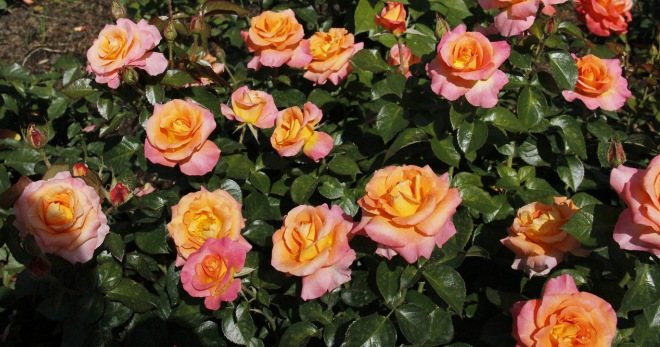
Popular hybrid tea roses delight people in almost every private garden, they are famous for their enchanting aroma, beautiful bud shape, and amaze with a variety of colors. Possessing such a magical flower, many summer residents do not know how to prune and care for the bush at all, which quickly affects the state of ornamental plantings.
Varieties of hybrid tea varieties
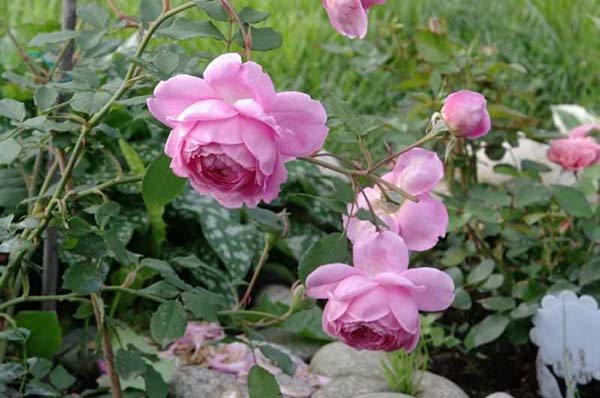

The photo shows a hybrid tea rose of the "Alyonushka" variety
Hybrid tea roses appeared not so long ago - in the 70s of the XIX century, a remontant rose and a tea rose were crossed. The result and the name of the creator of La France, the breeder Guyot, who immortalized his homeland in the name of the rose, is now known to all rose growers. But only 20 years later, the new species became popular, and today in the gardens you can find thousands of hybrid tea varieties, dazzling with their beauty, allowing you to revel in their aromas.
The bred varieties of hybrid tea roses inherited from the tea rose a beautiful bud shape, the finest, unfolding aroma and long-term flowering. Repaired varieties gave the charmer strength, durability, the ability to withstand cold winter.
Growing
Care for new seedlings should be careful, if they were not purchased from a nearby nursery, then there is a possibility that they were previously grown in a greenhouse. Plants are pruned, watered abundantly, a light shade is created, accustoming to the sun goes gradually.
During the entire growing season, the soil around the rose is loosened, mulched, fertilized, watered, freed from weeds and treated from parasites. The plant begins to bloom in the second half of June and blooms for a month, then there is a break that lasts two to four weeks, depending on the variety. Then flowering begins again and lasts almost until the very frost. When pruning at the end of October, it is sometimes necessary to cut whole buds. Some varieties bloom without interruption throughout the summer season. The rose needs to be fed almost constantly. Twice, in the spring, a lot of nitrogen fertilizers are given. After the first flowering, the plants are fertilized, the main elements of fertilization are: phosphorus, magnesium, potassium, the amount of nitrogen in the fertilizer decreases. In autumn, nitrogen is removed, potassium-phosphorus fertilizing is introduced.
Classification of hybrid tea roses
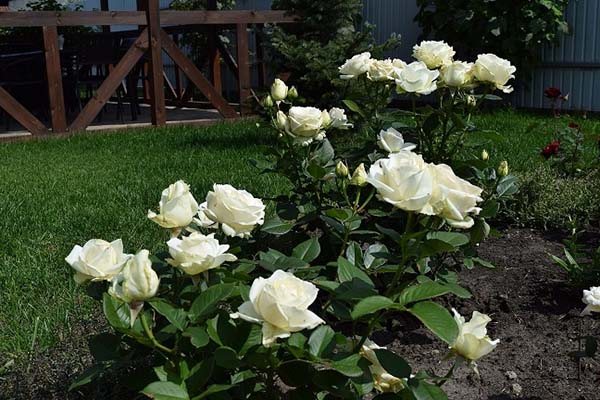

Pictured is a hybrid tea rose of the "Avalanche" variety
Roses are distinguished by the height of the bush: they distinguish undersized, medium-sized and tall varieties, in shape - from spreading bushes to pyramidal. But the main classification is the division of hybrid tea roses by color:
- red, burgundy;
- white, cream;
- pink, salmon;
- lilac, purple;
- yellow, apricot, orange;
- transitional, two-color.
IMPORTANT
Not all varieties are suitable for growing in the garden - some are exclusively for exhibition, and no one is given to admire them in their summer cottage.
Below will be a description of the most popular varieties of hybrid tea varieties of roses, often used in the landscape.
Choosing a material for planting
Rose seedling
When purchasing a seedling, it is necessary to take into account not only the height and color of the flower. A seedling suitable for planting has the following characteristics:
- Age - 1-2 years.
- Root collar with a diameter of 8 - 10 mm.
- Lack of leaves, flowers, fruits.
What else do you need to consider how to choose a rose seedling?
Inspect the seedling carefully when purchasing. Pay attention to:
- Seedling roots... Give preference to one with a well-developed root system that has ramifications. Such a plant will develop better.
- Number of stems... It is worth buying a seedling that has more than two stems. The stalks must be well developed and strong. The diameter of the stems is not less than 6-7 mm, the color is in a healthy green color.
- Kidney... Choose a seedling with dormant buds.
Red varieties of hybrid tea roses
Rose red is considered classic. Symbolizing love, passion, the scarlet, burgundy queen of flowers will decorate any landscape. Among the most famous burgundy red varieties:
- Black Baccara;
- Barkarole;
- Black Magic;
- Konrad Henkel;
- Sophia Loren and others.
Mr Lincoln (Mr Lincoln)


Hybrid tea rose, grade Mr. Lincoln
A hybrid tea rose with dark red velvet petals, collected in a dense bud, which, when opened, reaches a diameter of up to 10 cm.The rose blooms throughout the summer season, is beautiful in single plantings, but due to the fact that the variety is tall, it can reach up to 2 meters, used as a background in rose gardens. The rose has a strong scent that is easy to smell even from the background.
Black Magic
Tea-hybrid rose variety Black magic
This rose lives up to its name: unopened buds are almost black in color, gradually the rose begins to slowly reveal its secrets, but only the very middle petals can be called red, they are framed by noble velvet petals - a rich dark red shade with a black tint. When opened, the flower reaches up to 12 cm in diameter.
For its royal appearance, this variety is popular - it is good both in group plantings to create landscape design, and in cutting - in a bouquet the flower can stand without losing its aesthetic appearance for up to two weeks.
Grand Gala
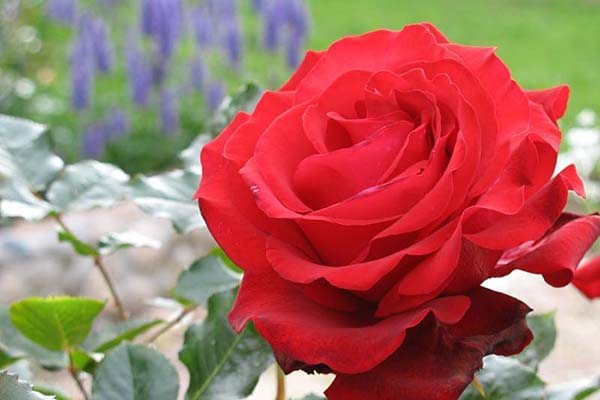

Hybrid tea rose variety Grand Gala
A low-growing variety of hybrid tea roses, which many growers do not take seriously until the bush opens beautiful red-burgundy buds. It blooms from mid-summer and pleases the eye until the frost, and 10-centimeter flowers keep loose for up to three weeks.
Good in the foreground in a rose garden, resistant to rain, disease. Able to stand for a long time in cut form.
Black Baccara
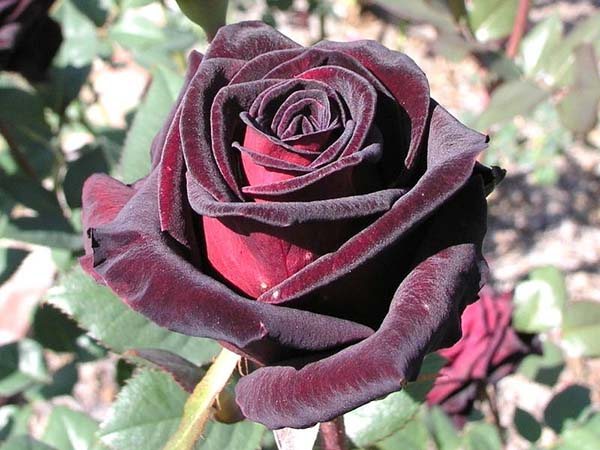

Hybrid tea rose variety Black Bakara
This rose is so dark that it is just right to attribute it to black, and not to red roses, this is recognized by all rose growers, as well as the fact that it is unrealistically beautiful. A medium-sized flower, up to 9-10 cm in diameter, exudes a slightly perceptible aroma. He feels good in the garden, but you should not hide such beauty among other roses. It is better to plant a black rose (this shade is pronounced in the bud and in its open form on cool autumn days) it is better to plant in partial shade - there the velvety burgundy-black tones of the rose will show their maximum beauty.
She is great in cut - due to her unusual color.
Rose Black Baccarat is the blackest rose
Admiral
Hybrid tea rose grade Admiral
Another enchantress who gradually reveals her secrets: black buds, as they bloom, form ruby-red flowers with a velvet bloom. The diameter of the flowers reaches 15 cm, the bush itself is low, up to a meter from the ground, but the sweet fruity aroma exudes far away.
A rose is good in any environment: in a rose garden, it goes well with other varieties, in separate groups it is planted against the background of a lawn, and in a vase on the table, its beauty will not leave anyone indifferent.
Gardeners reviews
Tatyana:
Cronenburg is a giant flower, buds are stuffed, there are a lot of petals, I never get sick at all.
Vyacheslav
Gloria Day variety. In general, a very beautiful variety (from my point of view), of the minuses - it fades quickly and lasts a maximum of 3 days in a vase. But the size of the flower is gorgeous.
The pink tenderness of the queen of the garden
From pale pink, almost white to bright saturated crimson - this is the range of shades, the shapes and sizes of the flower are also varied. The pink rose symbolizes elegance and sophistication. Refined tenderness - this is how varieties can be characterized, among which stand out:
- Vivaldi;
- Lady Like;
- Vien Rose;
- Lancome and others.
Ballerina


Hybrid tea rose, Prima ballerina variety
Outwardly unremarkable small flowers, but the bush is simply strewn with them, and it stands blooming until the first frost, due to which it is popular - for its decorative appearance. It is often used in hedges or to create curbs. The flowers open up dark pink, but very quickly change their color, fading, as a result, the light flower is bordered by only a pink strip. The reverse side is absolutely pale.
Vivaldi
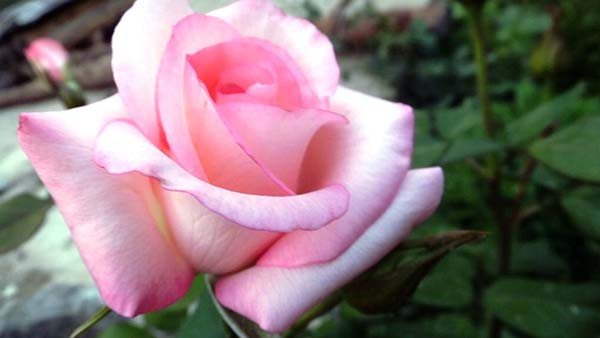

Hybrid tea rose, Vivaldi variety
Looking at this luxurious in all respects rose and pulls to hum: "To the music of Vivaldi ...". Its pale pink color, graceful size, large flowers make it one of the floristic varieties that adorn bouquets and flower arrangements. For planting in the garden, it is quite capricious - it is not resistant to rain, diseases, especially powdery mildew, black spot. Delicate "princess and a pea" - not only in color, but also in care - does not like the wind, the sun.
Lancome (Lankom)
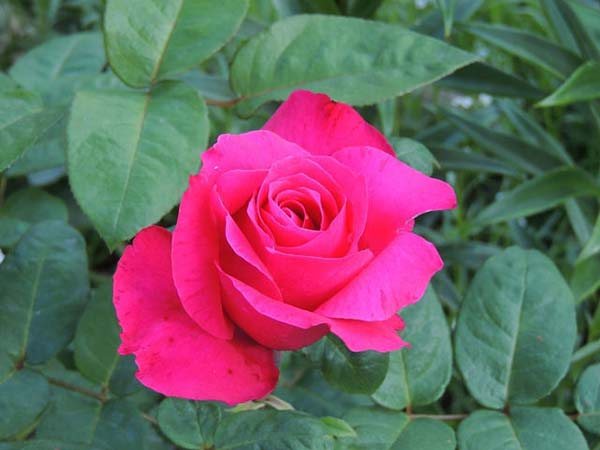

Hybrid tea rose, Lankom variety
The hybrid tea rose variety was bred in 1973. The tall glass is distinguished by the sophistication of the shape and color of fuchsia, the rose is good in cutting and is often grown indoors, where the capricious charming girl feels confident.
Flamingo
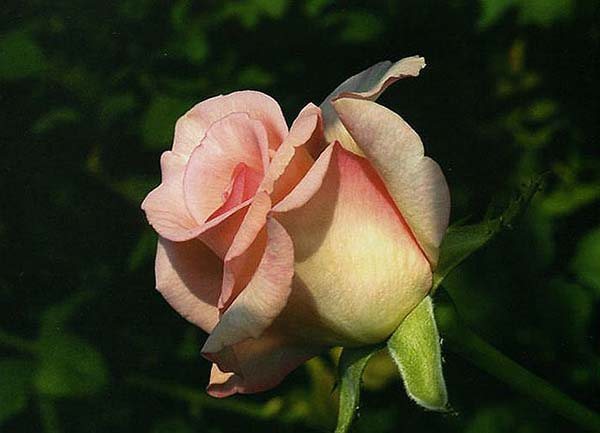

Hybrid tea rose, Flamingo variety
This variety is named so for a reason - the shade of the flower resembles the color of the European flamingo. The elegant flower blooms from ivory buds. Initially, the variety was bred for cutting, but it took root more in the rose gardens of country houses, in parks. Large, up to 10-12 cm flowers emit a delicate aroma, stay on the bush for a long time.
In landscape design, they are more often used in group plantings.
The specifics of flower care
In order for them to please with abundant flowering, it is necessary to properly care for the crops.
Hilling
It is produced so that the plant forms a bush and does not have a large growth. This method allows you to increase flowering and strengthen the roots, for hilling it is necessary to form a mound around the bush and huddle the shoots. This method has a positive effect on the plant and increases the size of the buds.
Bloom
During the flowering period, it is necessary to carefully monitor and timely remove the faded shoots, in the summer, after all the buds have faded, it is necessary to trim the upper shoots into 2 buds. Shoots that do not form buds are also removed.
Watering
The culture does not like moisture, watering is rarely done, however, with the use of liquid in large quantities. After planting in open ground, it is necessary to irrigate the plant every 3 days. Later, when the plant begins to form inflorescences, watering is carried out once every 5 days, while at least 10 liters of water should go to one bush.
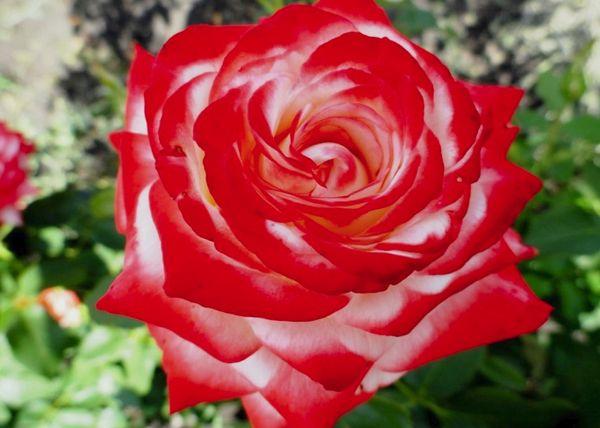

Important. In order for the roots not to be damaged during moistening, it is necessary to pour the liquid in a thin stream into the soil.
Pruning
The rose bush requires regular pruning, which is done according to the following scheme:
- the first pruning is carried out in the first year, while the plant is shortened by several buds;
- in the fall in the first year, all flowering shoots are cut off;
- in the spring of the second year, it is necessary to circumcise, leaving no more than 4 buds;
- in the fall, all damaged shoots are removed, the plant is cut into 6-7 buds for further shelter.
See also
Description and characteristics of Robusta roses, subtleties of planting and careRead
Pruning hybrid tea roses for the winter is done at the end of September before the onset of the first frost.
Top dressing
For flowering, it is necessary to monitor the condition of the soil and in a timely manner makes all the necessary bait.
Top dressing can be done according to the following principle:
- in the spring, before the formation of buds, organic fertilizer is used;
- in the fall in the first year, it is necessary to prepare the plant for winter and spray it with potassium sulfate (2 tablespoons per 8 liters of water);
- in the second year in the spring, a urea solution is used, which is introduced after pruning;
- in mid-May, a mullein solution is used (one kilogram per bucket of water);
- in the middle of summer, it is recommended to use an infusion of chicken manure;
- in September, wood ash is used as root feeding and humus.
If the gardener notices symptoms of a lack of useful components, it is necessary to use mineral fertilizers.
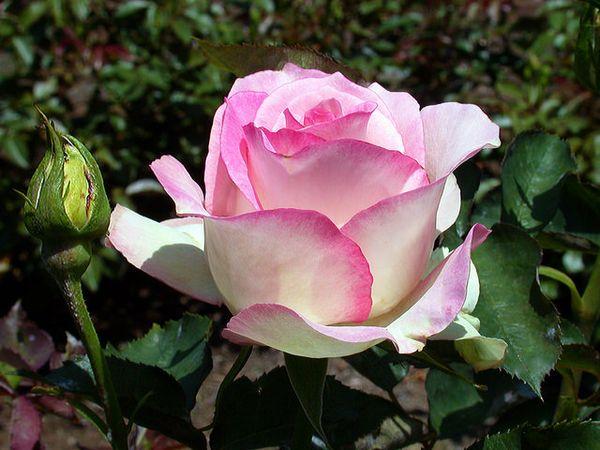

The color of tenderness and purity
Of course it's white. Along with it, creamy shades of roses stand out - the same refined, sophisticated:
- Grand Mogul;
- Osiana;
- Jardins de Bagatelle and many others.
It's interesting What white roses symbolize
Jardins de Bagatelle (Bagatelle Gardens)
Hybrid tea rose, variety Sady Bogatel
The rose has large flowers of a beautiful shape and unusual color - on top they are creamy with a pinkish tint, and on the inside - dark apricot. Having fully blossomed, the flower will slightly lose brightness, but the creamy peach middle will remain unchanged.
The variety is resistant to diseases, not picky about soil and climate, it will decorate both the garden and the bouquet.
Both initially and repeatedly bloom profusely, therefore it is often used in landscape design.
Avalanche
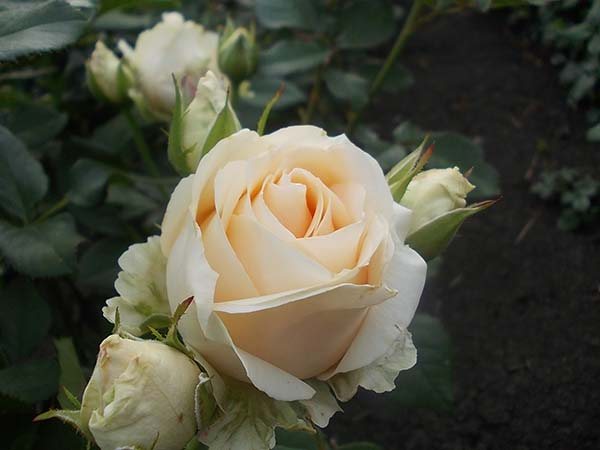

Hybrid tea rose, grade Avalange
An extraordinary beauty, a queen - moderately sweetly fragrant, having a sense of her own dignity, a rose with white, slightly emerald-like, large flowers will decorate a garden, a park alley. She is good both in group plantings and solo. Self-sufficient, unpretentious, resistant to diseases, including powdery mildew, it is one of the favorite varieties of rose growers and florists. In a bouquet, this rose without words will tell about the tender feelings of the donor.
Evening Star


Hybrid tea rose, variety Evening Star
Another variety of hybrid tea roses that can tell about tenderness and love. Beautifully arranged in a spiral, the petals are large, reaching 8-10 cm in diameter.
A luxurious bush will decorate borders, can be planted in containers, looks great in a bouquet.
Plant by layering, dividing the bush and grafting
| Method 1. Growing by layering Landing scheme:
| |
| Method 2. Growing by dividing the bush Landing scheme:
|
| Method 3. Cutting Landing scheme:
|
Under the color of the sun
Yellow and orange roses are filled with light, sun, they attract attention in the flower bed, standing out among other varieties of roses. It is impossible, speaking of the queen of flowers, to ignore:
- Arlequin;
- Wisky;
- High Magic and others.
Gloria Dei
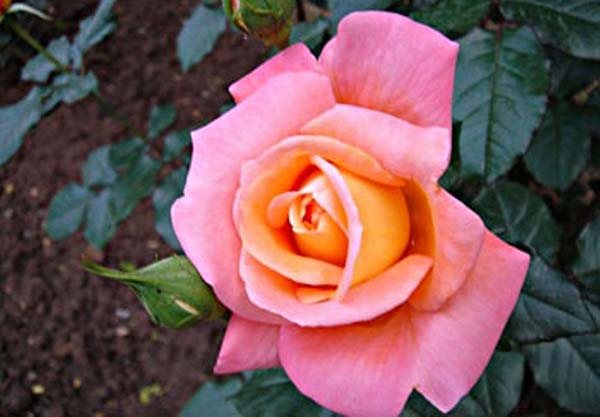

Hybrid tea roses, Gloria Day variety
This hybrid tea rose has many names - Mme. A. Meilland in France, Gioia in Italy, in many countries it is known as Peace, and in Germany as Gloria Dei. The variety that received the title of "Rose of the XX century", shrouded in legend. It was bred by a French breeder and named after a mother who died early. Rose cuttings ended up in the United States in diplomatic baggage literally on the eve of the seizure of France by Nazi Germany, in America it was multiplied and in April 1945 it was presented under the name Peace. She was destined to decorate tables during UN meetings.
But the beauty owes not only such an amazing story - her large beautiful flowers are beautiful both in unblown buds and in full disclosure. After going through several stages, the flower changes color - pale yellow petals in a crimson frame become creamy pink, but the shades and smell of the flower depend on the season, the place of cultivation. Therefore, everyone describes this rose in his own way - both color and aroma. Everyone agrees on one thing: she is beautiful!
Doris Tysterman (Doris Tysterman)
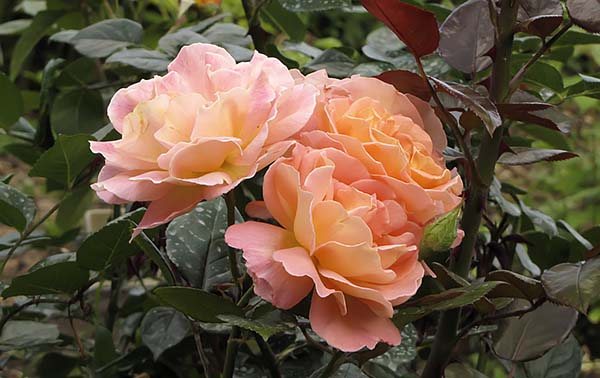

Hybrid tea rose, variety Doris Tisterman
A hybrid tea rose of orange color, more precisely, its petals are yellow on top and crimson below, shadows play in them creating illusions, so the rose looks orange in the sun. Another feature of the variety is that its outer petals are noticeably larger than the inner ones, so they seem to border the bud.
Shades can vary, ranging from light peach to rich tangerine. The color can be influenced by the soil, the planting site - sunny or partial shade. The bush itself is small in height, up to a meter, but very lush, so it takes up a lot of space, which must be taken into account when planting a rose. It blooms continuously until autumn, therefore it is popular in landscape design, and given its size, it feels better in single plantings.
High Magic
Hybrid tea rose, variety High Magic
"Dancing flame", so you can call a rose, the flower of which has a regular cone and an unusual color - from the center to the edges of the petal, the color changes from orange to red, due to which the effect of living fire is achieved. The bush has practically no smell, except that in the early morning a subtle aroma accumulates in the air. The variety is unpretentious, undemanding and disease resistant.
Versilia (Versilia)
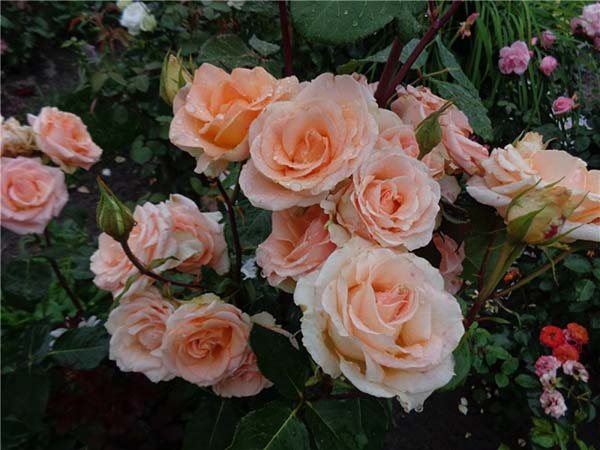

Hybrid tea roses, variety Versilia
It is impossible not to admire its delicate peach flowers. She will decorate bouquets, become a garden decoration. Soft pastel colors, turning into pink-peach, are good both in group compositions and in solo performance.
The rose survives the winter well, but requires attention to itself - pruning, protection from frost, especially in spring.
Christophe Colomb (Christophe Columbus)
Hybrid tea rose, variety Christopher Columbus
A bright, spectacular hybrid tea rose of orange-scarlet color with a yellow petal base, it attracts attention from afar. It is not capricious, has a pleasant smell, therefore it is more often grown for garden decoration than for bouquets. It is a pity to cut off such beauty, but in landscape design, due to its short stature - up to one and a half meters - it is used both in single plantings and in group ones.
This is interesting Yellow roses - the meaning of color
Care features
Requirements for soil, light and moisture
Climber roses
Hybrid species are quite demanding on the composition of the soil. They do not like lime and a large amount of loam, and also grow poorly where groundwater lies close to the surface. Before planting, add manure, compost, peat, or store-bought nutrient mix to the soil.
Attention! Plants tolerate drought well, because the root system goes deep into the soil, but they do not like the scorching sun, wind and drafts. Excessive soil moisture can lead to fungal diseases.
Landing
It is necessary to plant plants as follows:
- First you need to check if the soil is suitable for planting. To do this, a lump of earth is squeezed in the hand and thrown. If it breaks, the ground is good for planting.
- Further, the root system of the rose bush is maximally exposed.
- The plant is placed in a pre-dug hole with a nutrient mixture.
- The roots are gently straightened.
After that, the pit is thrown with earth. You can water a little the soil around the seedling and gently loosen it to absorb moisture better. Bushes of white and pink varieties take root best.
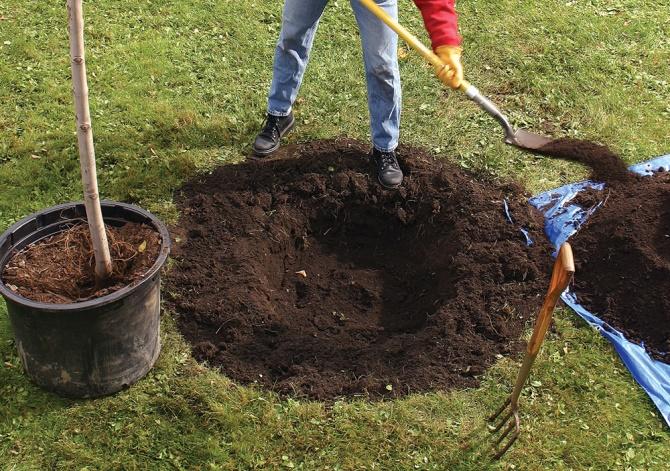

Landing pit
Basic care activities
In the spring, plants definitely need feeding; for this, dry industrial fertilizers can be used. The powder is scattered under rose bushes and mixed with the pova with a hoe for better absorption.
To combat weeds, loosening and mulching are actively used. Mulching is used in cases where the weed has very deep roots (loach, wheatgrass, sow thistle). In this case, it is not recommended to dig up the weed by the root, as the roots of the cultivated plant may be damaged. The mulch layer suppresses the growth of weeds.
Withered leaves and flowers must be removed in a timely manner. Otherwise, they can rot and the flower will become seriously ill. This happens especially often in rainy summers.


Pruning roses
Below are the Top 10 most unpretentious varieties to care for, suitable for growing in the Middle Lane:
- deep crimson with white inserts Fantasy (Fantasia);
- white-green Green Ice;
- white with pink border Ambiance;
- red with white stripes Red Intuition;
- striped variety Abracadabra;
- red and white variety Henri Matisse;
- yellow-pink grade Marvell;
- white with pink edge Crazy Wang;
- red with wavy edges From Dasted;
- variegated varieties - all species names, zoned for the Moscow region.
These varieties are characterized by good resistance to cold weather, but require shelter for the winter.


Yellow-pink grade Marvell
Formation of culture
The formation of a culture takes place through pruning. During pruning, the following rules must be observed:
- after pruning, the bush should become half the size;
- dried branches are cut to the very base so that the cut bush looks beautiful and neat;
- a thin growth must be left, then the flowering will be more intense;
- all cut shoots, flowers and leaves are burned, as they can be affected by diseases and pests;
- pruning is done in the spring to prepare the plant for flowering.
In some flowers with a certain color, the lack of regular pruning leads to deformation of the bush and shoots. The list is presented below:
- red-orange roses;
- variegated rose;
- rose red-yellow;
- tiger rose Fantasy;
- roses are crimson pink;
- striped roses;
- motley rose Fantasy;
- rose of Obrigado.
Rose Obrigado
These varieties need to be pruned, if possible, not only in spring, but also in autumn.
Reproduction
Among the two-colored species, miniature varieties are often found. They are most conveniently propagated by cuttings. Before planting, they are soaked in a growth stimulator, after planting they are kept for some time under a film, for better adaptation to changed conditions. Cuttings develop into full-fledged pink seedlings after about 2 years.
Tall varieties are usually propagated by layering and dividing the bush. To do this, you need to dig out the roots, and then make a neat dig with a sharply sharpened shovel and with a quick dexterous movement remove the bush from the ground without deforming the root system. At least 3 shoots must be left on each part of the root.Then the root is cut into pieces.
Attention! If during digging up some small roots break, do not worry, a healthy plant will calmly tolerate this minor loss without any stress. The main thing is not to touch the main root rod.
All shades of lilac
If you make a description of all varieties of roses of lilac shades, you will need many pages, because each rose, be it purple-violet Violette or luxurious lilac Blu Moon, is good in its own way.
Blu Moon
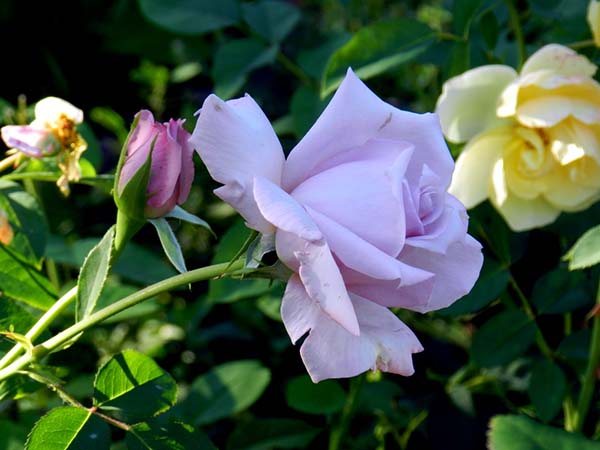

Hybrid tea rose, Blue Moon variety
This unusually delicate hybrid tea rose has several names - Blu Mondey, Sissy, Mainzer Fastnacht, but they all mean a lilac rose of an extraordinary shade, which is so famous and loved by rose growers of all countries that its name does not matter anymore. Slowly, slowly, a large bud opens up, which is beautiful at all stages - a closed purple-lilac glass, a lighter rose fully opened with a strong aroma.
From afar, you first feel this smell, it attracts, attracts, and when you come close, you admire the flower itself. The shades of a rose can vary - from silvery-lilac to lilac-purple, slightly bluer if the bush grows in a sunny place, and slightly pinker in a shady place.
Landscape designers often assign a place to it in large tracts, it is difficult to combine it with other varieties. The rose is resistant to diseases, calmly tolerates not too cold winters.
Paradise
Hybrid tea rose, variety Paradise
Another beloved variety of hybrid tea roses, and again - lilac. Burning Sky (Sky on fire), Passion (Passion) - this is also about her, which opens gradually, changing colors as the bud opens. The silvery color with a slightly lavender hue and a thin red border along the edge of the petal gradually changes to a more intense, but still delicate lavender, and the border becomes wide and bright crimson. You can observe the bush every day and be surprised at its changes.
Therefore, landscape designers recommend it for the design of parks, squares, private suburban areas.
Preparing for winter
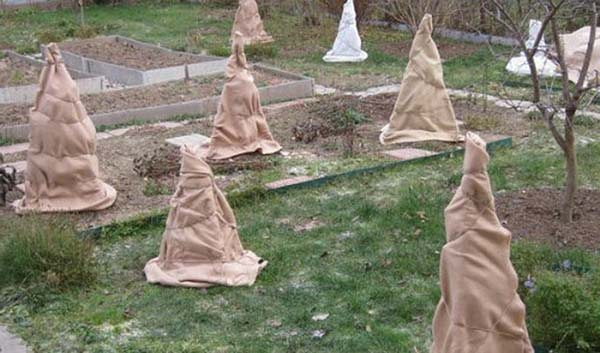

Preparing roses for winter
Winter, the time when the rose does not please us with its flowering, is also an important period in the life of a flower. At the same time, this is a difficult period for which the plant needs to be prepared.
In order for the rose to endure the frosty winter and not die, it is necessary to create special conditions for it. The plant is cut, leaving shoots no more than 10 cm. Excess shoots are removed. To disinfect the sections, sprinkle them with ash. Then the rose bush is spud, covering the left shoots with dry foliage or branches of fir trees.
You can cover the bush with a wooden box, and wrap it with agrofibre on top of it. If you choose this method, do not try to wrap the rose completely, be sure to leave an air space to allow air circulation.
It is impossible to use sawdust, hay, straw, moss, manure when preparing a rose for winter! These materials will lead to dampness, decay of roots, death of the flower!
Bloom
Mass flowering occurs in June-July and lasts 30-35 days, after which it stops: early varieties do not bloom for 15 days, late ones - up to 30. For the second time, the plant will delight you with its luxurious buds right up to late autumn.
If you need flowers for a bouquet, remember that you can immediately cut no more than 2 flowers from one bush.
How to make it
The preparation of slurry is as follows: a natural mullein should be put into a vessel and water is poured there in a ratio of 1: 3, 10-12 g of superphosphate and the same amount of potassium sulfate per 1 bucket of water are added to the liquid. This solution must be mixed thoroughly and left to infuse for 2 weeks. Before using the slurry mixture, it must be diluted with water in a ratio of 1:10. Before fertilization, shallow paths should be created in the interval of 35-40 cm from the lateral branches of plants, these grooves should be poured with water and only then - with a liquid from the diluted gruel.The consumption of the solution for each bush should be somewhere around 5-6 liters (1 bucket for 2 bushes). After the earth is dry, the paths need to be sprinkled with dry soil, and a day later, loosen the soil around the bushes.
Hilling
To protect the lower buds from heat and cold, it is necessary to huddle. In no case should the seedlings be given the opportunity to bloom immediately after planting. Therefore, the first five buds must be broken off. This is done to strengthen and strengthen the root system. Only after the bush reaches 50 cm in height is it allowed to bloom.


Rose propagation methods
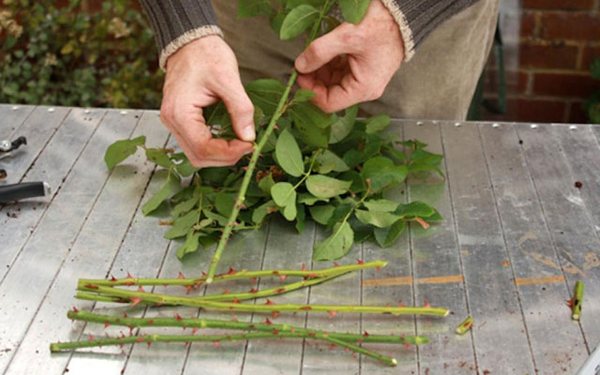

There are many ways to propagate roses, but the most popular is cuttings. In this case, it is better to use semi-lignified cuttings. Fully ripe and too young shoots are not suitable. If you are going to cut a bush, do not feed it with nitrogen fertilizer in the spring, such cuttings take root worse. It is better to cut the shoots after the first wave of flowering.
Cuttings should be taken from the central part of the stem. Each of them should be 5-8 cm long and have several leaves. The lower cut is made obliquely under the kidney itself, the upper one - above the kidney. To reduce evaporation of moisture from the leaves, they are shortened. You cannot completely pick off the leaves, without them the cutting will not take root. 20 hours before planting, the cuttings are soaked by dipping the lower end into a solution of a root formation stimulator (Kornevin, Heteroauxin, aloe juice).
You can plant the material directly on the garden bed in a mixture of sand and vermiculite (vermiculite can be replaced with peat). The place should be such that the sun's rays fall on it in the morning or evening. Planting should be done obliquely, to a depth of 2 cm. Each stalk must be covered with a plastic bottle to create greenhouse conditions. The soil is regularly moistened by spraying. The roots will appear in about a month.
An adult overgrown bush can be propagated by division. The procedure is carried out in the spring. Each section should contain several shoots and roots. After planting, the shoots are shortened, leaving 3 buds on each of them, making the cut outward. The wounds are covered with garden pitch. Before planting, it is advisable to dip the roots in a clay mash.
Landing in open ground
Purchased in advance the seedling is stored in a container with damp earth or sand, placed in a cool place - basement or refrigerator. Outdoor landing is performed in May-June, it is important to be in time before the onset of heat. In this case, it is necessary that the earth warms up to +12 ° C.
Before the procedure the roots of the seedling are lightly trimmed and placed in water for 2 hours to drink moisture, you can also put the whole plant in liquid.


The depth and width of the hole should allow the roots of the plant to be placed freely without bending. Half of the space is filled with a mixture of organic fertilizers (peat, humus, cow dung) and sand - the proportions are equal. Dry soil is pre-wetted.
Further, the seedling is placed in a recess. Here you should pay attention to the thickening - the site of inoculation. It must be lowered 2-3 cm underground. Then the missing soil is filled up and compacted. An earthen roller is built around the plant, which will prevent water from spilling over.
Photo
Load more photos
Pruning
Removing some of the shoots plays an important role in the correct maintenance of the rose. There are several trimming options:
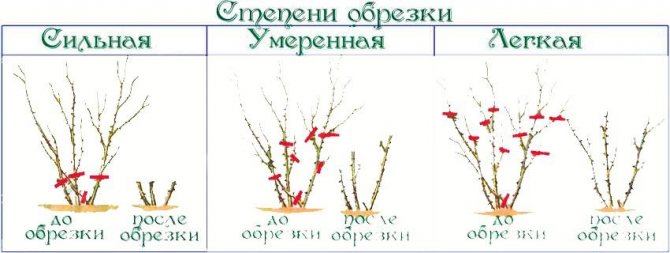

- Strong - is to remove most of the escape. As a result, only 3-4 kidneys remain. This option allows you to get large flowers in smaller quantities. The beginning of flowering is postponed to a later time.
- Weak - consists in cutting off the damaged or frostbitten upper part of the shoot. Flowering in this case is early, there are many buds, but the flowers are small.
- Spring - is the most important. It is performed when the kidneys reach a size of 5-8 mm. On low-growing varieties, 3-4 buds are left with a total shoot length of 15-20 cm.On tall bushes, 8 buds remain on a total length of 30 cm.
- Summer - performed when the plant has bloomed. Wilted buds and a small part of the shoot are cut off. In this case, the power of the plant is not spent on the formation of fruits, which will allow you to get more abundant flowering for the next season.
- Autumn - is necessary as preparation for the winter period. It consists in removing unripe and damaged stems. It is carried out carefully so as not to cut off the excess.
Important! All trimmed material is placed away from the bushes and burned in case pathogens are found there.
Lilac and blue varieties
Blue Moon variety
Translated into Russian, the flower is called "Blue Moon". The variety was created in Germany in 1964.
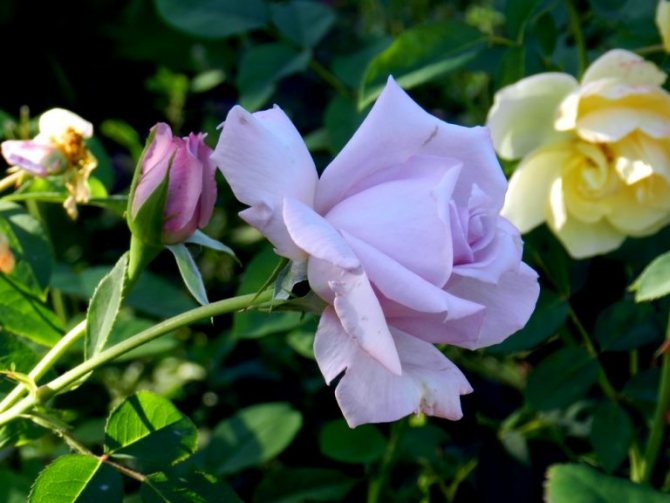

- Bush 90 - 120 cm high, neat, practically no thorns
- Leaves are dark green, very shiny
- Petal color: lilac, does not fade, turns pink in the shade, blue in the sun
- Flowers 10-13 cm in diameter, large, double, up to 36-40 petals
- The aroma is strong, intense
- Disease resistance is average, it is necessary to spray against powdery mildew, is not afraid of rains
- Winter hardiness is high, but it is advisable to cover
- Grown for cutting, has a long stem.
Variety Charles de Gaull (Charles De Gaull)
The variety was created and dedicated to the songs of Mireille Mathieu in 1975, which Charles de Gaulle loved very much. At her request, he became the godfather of her younger brother.
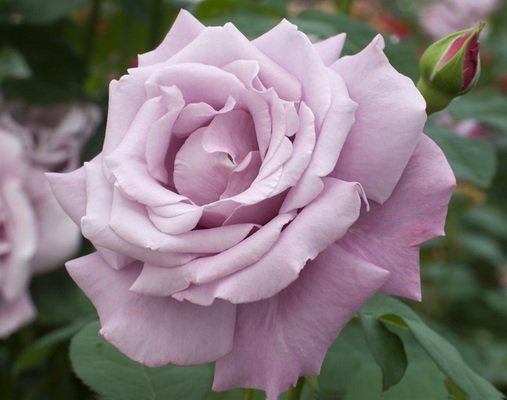

- Bush up to 1.2 meters high, erect, with long thorns
- Leaves are dark green, glossy
- Petal color: lavender-colored petals, when blooming become bluish-lilac
- Flowers with a diameter of 13-14 cm, goblet, double, up to 40 petals, wavy edges
- Strong aroma with notes of citrus and verbena
- Disease resistance is high, but preventive spraying is needed
- High winter hardiness, does not require shelter
- Grown for cutting and for bouquets, it belongs to especially valuable varieties.
Blue Nile cultivar
Created in France in 1981, in the same year received the Bagatelle gold medal as a new variety at the international competition in Paris.
- Bush up to 150 cm high, prickly
- Leaves are dark green, glossy
- Petal color: bluish lilac
- Flowers up to 12 cm in diameter, terry, up to 35 petals
- The aroma is pleasant, with notes of citrus and tea, the smell attracts bronzes (minus)
- Disease resistance average
- Winter hardiness is above average, requires shelter
- Grown for cutting and garden decoration.


